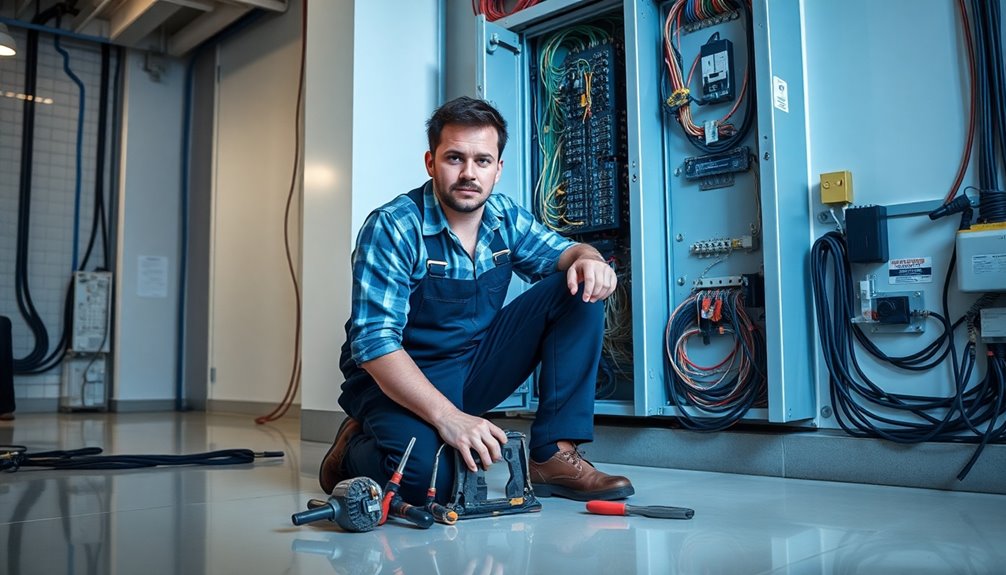To detect hidden electrical wiring faults, you’ll want to combine visual inspections with specialized tools. Use a flashlight and look for damage, corrosion, or loose connections behind walls or panels. Employ circuit testers and non-contact voltage detectors to identify live wires safely. You can also perform insulation resistance tests, or use infrared thermal cameras to spot hot spots. Tracing devices and advanced sensor technologies help find concealed wiring issues more accurately—keep exploring to discover more effective inspection techniques.
Key Takeaways
- Use infrared thermography to identify hot spots indicating loose connections or insulation damage behind walls.
- Employ cable tracer and locator devices to detect and trace hidden wiring paths safely.
- Perform insulation resistance testing with a megohmmeter to identify deterioration or damaged insulation in concealed wiring.
- Conduct physical inspections of accessible areas for scorch marks, corrosion, or loose fittings that suggest hidden faults.
- Implement continuous monitoring with smart sensors to detect early signs of wiring faults before they cause failures.
Visual Inspection Techniques for Concealed Wiring

While concealed wiring makes visual inspections more challenging, it remains a crucial step in detecting electrical faults. You should start by carefully examining accessible areas like electrical panels, junction boxes, and outlet covers. Look for signs of damage, such as scorch marks, discoloration, or loose connections. Pay attention to any unusual wear, corrosion, or exposed wires that may indicate a problem. Use a flashlight to illuminate dark corners or hidden spaces where wiring runs behind walls or ceilings. Check for signs of water damage, mold, or pests that could compromise wiring integrity. Take note of any loose fittings or improperly secured wires. Although difficult, thorough visual inspections help identify potential issues before they cause serious faults or hazards. Additionally, understanding the role of contrast ratio can assist in assessing the visibility of wiring in dimly lit areas, making detection easier.
Using Circuit Testers and Voltage Detectors
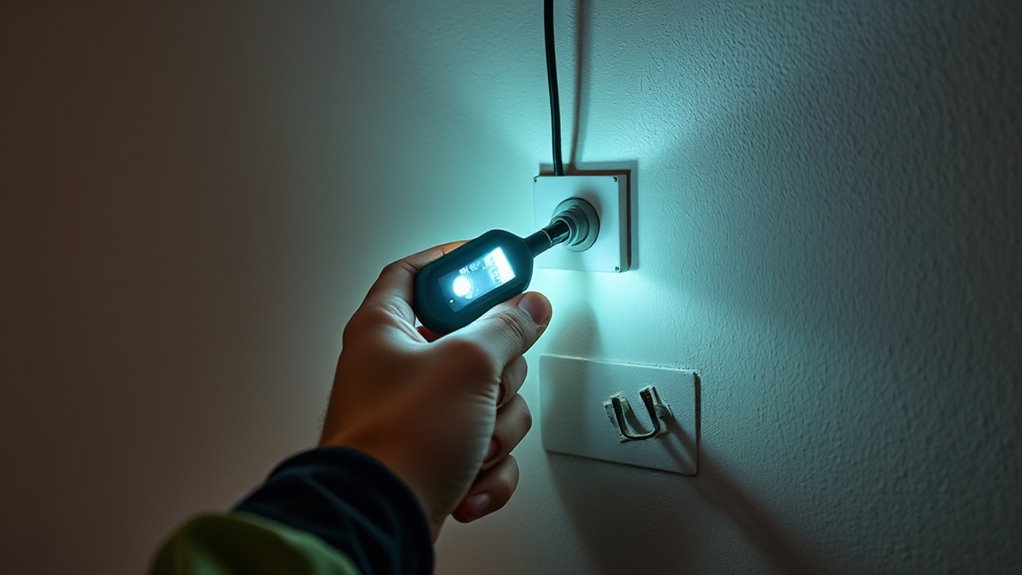
After performing visual inspections, using circuit testers and voltage detectors allows you to verify the presence of electrical faults more accurately. These tools help you determine if wires are live or dead, confirming suspected issues identified during the visual check. With a circuit tester, you can quickly identify whether outlets or switches are receiving power, while a voltage detector offers a non-contact way to sense voltage presence without touching the wires. Always follow safety protocols, such as turning off power before testing, to prevent shocks. Proper use of these devices helps you pinpoint hidden faults, like broken connections or reversed wiring, without invasive methods. Understanding electrical wiring and its common faults can further improve troubleshooting accuracy. This step provides clear, immediate feedback, making it easier to narrow down problem areas before proceeding with further testing or repairs.
Employing Insulation Resistance Testing
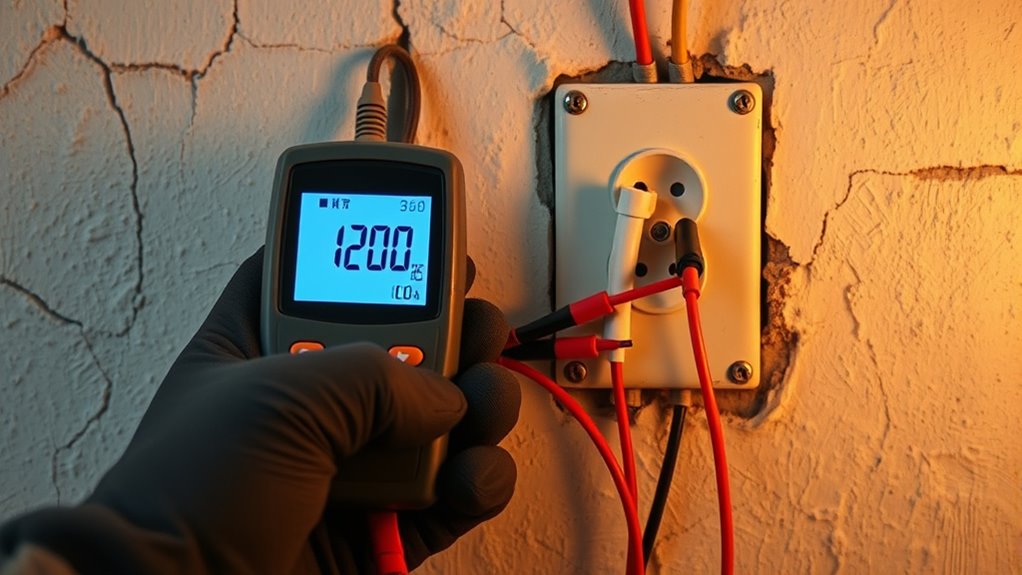
Insulation resistance testing helps you identify potential faults by measuring the quality of insulation around conductors. You’ll need to understand the proper testing methodology to get accurate results. Interpreting resistance values correctly allows you to determine if wiring insulation is still effective or needs attention. Incorporating data privacy considerations into testing procedures ensures sensitive information remains protected during inspection processes.
Testing Methodology Overview
Employing insulation resistance testing is a key method for evaluating the integrity of electrical wiring. To perform this test, you connect a megohmmeter between the conductor and ground, ensuring the circuit is de-energized. You then apply a specified voltage, typically between 500V and 1000V, depending on the wiring specifications. During testing, you observe the resistance reading, which indicates the level of insulation quality. A high resistance value suggests good insulation, while a low value points to potential faults or deterioration. It’s important to perform tests systematically, covering all circuits and wires, and to record your readings accurately. This methodology helps identify hidden issues that could lead to faults or hazards, providing a foundation for further analysis and repairs. Additionally, understanding lifestyle factors such as workspace organization and lighting can influence the accuracy of your assessments and the safety of electrical setups.
Interpreting Resistance Values
Interpreting resistance values accurately is essential for evaluating the condition of electrical wiring. When you perform insulation resistance testing, you’re measuring the resistance between conductors and ground to identify potential faults. High resistance readings, typically in the megaohm range, indicate healthy insulation with minimal leakage. Conversely, low resistance values suggest deterioration or damage, possibly signaling moisture, wear, or compromised insulation. It’s important to compare your readings against manufacturer specifications or industry standards for similar systems. Keep in mind that ambient temperature and humidity can influence measurements, so consider these factors during interpretation. Consistently low or decreasing resistance over time can signal developing faults, prompting further investigation. Proper interpretation of resistance values ensures safe, reliable electrical systems and helps you catch hidden issues before they escalate.
Thermographic Imaging to Spot Hot Spots
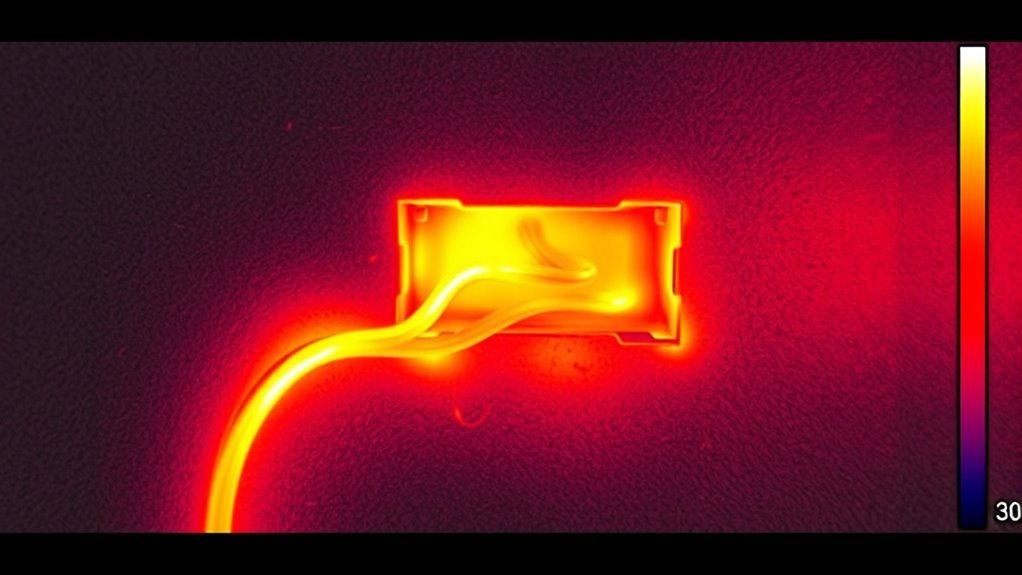
Thermographic imaging provides a quick and non-invasive way to identify electrical wiring faults by detecting hot spots that indicate abnormal temperature rises. When you use infrared cameras, you can visualize temperature differences across wiring and electrical components, pinpointing areas of concern before they cause a failure. Hot spots often reveal loose connections, overloaded circuits, or damaged insulation that aren’t visible to the naked eye. By regularly inspecting with thermography, you can catch issues early, saving time and avoiding costly repairs. Additionally, advancements in AI-powered thermal analysis can enhance the accuracy and efficiency of fault detection. AI-powered thermal analysis helps identify subtle temperature variations that may be missed by manual inspection.
Cable Tracer and Locator Devices
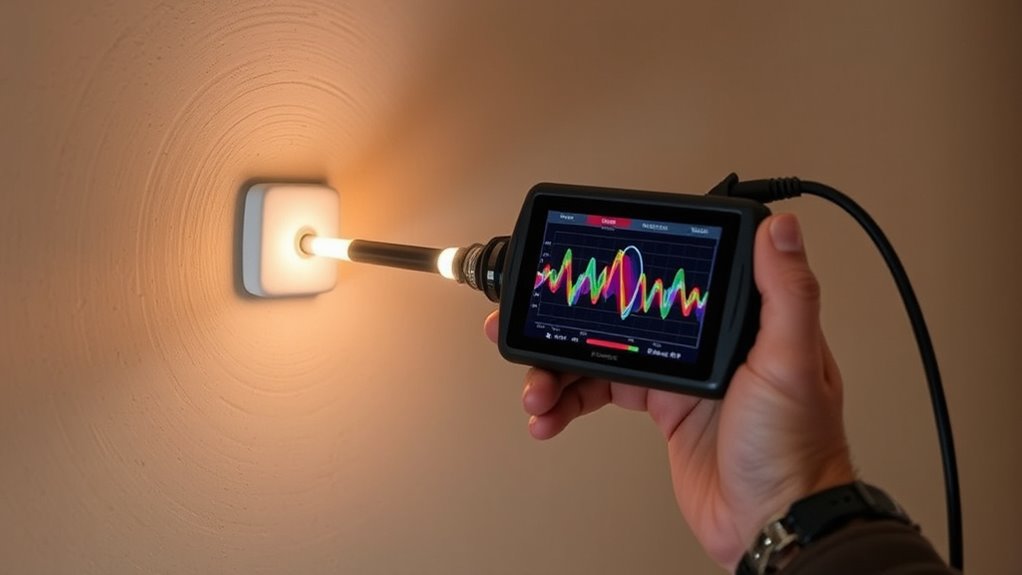
Cable tracer and locator devices help you find and identify wiring hidden behind walls or underground. You’ll learn how these tools work, the different types available, and essential safety precautions. Using them correctly guarantees accurate results and keeps you safe during the process.
How Cable Tracers Work
To locate electrical wiring accurately, cable tracers and locator devices send signals through the wires and detect them with specialized receivers. These devices work by injecting a unique signal into the cable, which travels along its length. The receiver then picks up this signal, helping you trace the wire’s path and pinpoint its location. The process is quick, non-invasive, and precise, making it ideal for identifying hidden wiring behind walls or underground. Having access to regional legal resources can assist in understanding local regulations related to electrical work and safety standards.
- The signal is designed to be distinguishable from electrical noise, ensuring accurate readings.
- Some tracers can differentiate between live and dead wires for safety.
- Advanced models integrate digital displays for real-time tracking and exact depth measurement.
Types of Locator Devices
There are several types of locator devices designed to help you find electrical wiring accurately. Cable tracers are common tools that send a signal through the wire, allowing you to follow its path with a receiver. These are useful for locating circuits behind walls or underground. Signal generators are another type, which attach to the wire and emit a distinct tone or signal, making it easier to trace. Clamp meters can also serve as locators by detecting magnetic fields around energized conductors. Some advanced devices combine multiple functions, offering both signal injection and detection capabilities. Choosing the right device depends on your specific needs, the environment, and the type of wiring you’re working with. Proper selection guarantees precise, safe, and efficient wiring detection. Additionally, understanding Kia Tuning options can help optimize vehicle performance during electrical modifications.
Safety Precautions to Follow
Using cable tracer and locator devices safely is crucial to prevent accidents and guarantee accurate results. Always read the manufacturer’s instructions before use to understand proper handling. Wear insulated gloves and avoid contact with live wires to minimize electric shock risks. Keep the device away from water and moisture, which can cause malfunctions or shocks. Confirm the area is clear of obstructions and other electrical equipment before starting. Regularly inspect the device for damage or worn parts to ensure safe operation. Proper calibration and device maintenance are essential for reliable performance and safety. Test the device on a known live circuit first to confirm it works correctly. Use the correct setting for the specific cable or wire type. Keep a safe distance from high-voltage lines during tracing.
Advanced Technologies: Partial Discharge Detection and More

Advanced technologies have revolutionized the way electrical wiring faults are detected, with partial discharge detection standing out as a particularly effective method. This technique involves identifying tiny electrical sparks within insulation that indicate deterioration or developing faults. By using specialized sensors and high-frequency measurements, you can detect these discharges before they cause major failures or hazards. Partial discharge detection is especially useful for inspecting complex or inaccessible wiring systems without invasive procedures. Additionally, other advanced tools, like infrared thermography and acoustic analysis, complement this approach by revealing heat anomalies or sound emissions associated with faults. Implementing these technologies allows you to pinpoint issues early, reduce downtime, and enhance safety. Embracing these innovations guarantees your electrical systems remain reliable and safe over time. Moreover, understanding AI security vulnerabilities, such as potential biases or jailbreak techniques, can help in developing more robust diagnostic tools and ensure safer electrical infrastructure management.
Best Practices for Ongoing Electrical System Monitoring
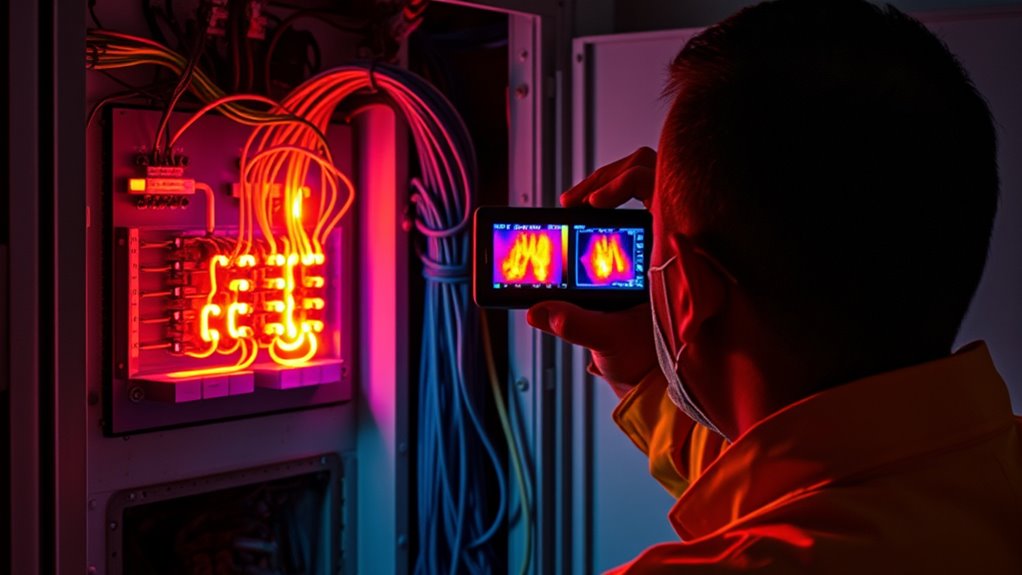
Effective ongoing monitoring of your electrical systems is essential to maintaining safety and preventing costly failures. Regular checks help catch issues early before they escalate, saving you time and money. To stay ahead, implement a proactive maintenance plan that includes routine inspections and data analysis. Use smart sensors and real-time monitoring tools to identify abnormal patterns instantly. Keep detailed records of all inspections and repairs to track system performance over time. Additionally, train your team to recognize early warning signs of faults and ensure they understand how to respond quickly.
- Install continuous monitoring devices for key components
- Schedule regular inspections and testing
- Analyze data trends to predict potential failures
Frequently Asked Questions
How Often Should Concealed Wiring Inspections Be Performed?
You should examine concealed wiring at least once every three to five years, depending on your home’s age and usage. Regular checks help catch potential issues early, preventing hazards like fires or electrical failures. If you notice flickering lights, unusual smells, or sparks, perform an inspection immediately. Staying proactive with inspections ensures your wiring remains safe and reliable, giving you peace of mind and protecting your home and loved ones.
What Are Signs of Hidden Electrical Faults in Walls?
You should watch for signs of hidden electrical faults in walls, like frequent circuit breaker trips, flickering lights, or warm outlets. Unusual buzzing sounds or a burning smell also indicate potential issues. If outlets or switches feel hot or if you notice discoloration, these are warning signs. Trust your instincts—if something seems off, it’s best to have a professional inspect your wiring to prevent hazards.
Are There Safety Risks Associated With Electrical Fault Detection Methods?
Think of electrical fault detection as traversing a minefield—you need to proceed carefully. While these methods are generally safe, there’s still a risk if you’re inexperienced or ignore safety protocols. You might accidentally cause a short circuit or electric shock. Always wear protective gear, turn off power before inspecting, and consider hiring a professional. Proper precautions ensure your safety, turning a dangerous maze into a manageable task.
Can Hidden Wiring Faults Cause Fire Hazards?
Hidden wiring faults can definitely cause fire hazards. When wiring is damaged, loose, or improperly installed, it can overheat or spark, increasing the risk of a fire. You might not see these issues directly, but they can lead to dangerous situations. Regular inspections and proper detection methods help you identify and fix hidden faults early, reducing the chance of a fire and keeping your home safe.
What Maintenance Schedule Is Recommended for Electrical Systems?
You should follow a regular maintenance schedule for your electrical systems to guarantee safety and reliability. Inspect your wiring, outlets, and switches at least once a year, and schedule professional inspections every 3 to 5 years. Keep an eye out for signs of wear, overheating, or damage, and address issues promptly. Proper maintenance prevents potential hazards, including hidden wiring faults that could cause fires or electrical failures.
Conclusion
Regularly inspecting your hidden electrical wiring can prevent costly repairs and guarantee safety. Did you know that faulty wiring causes nearly 20% of electrical fires? By using techniques like thermographic imaging and cable locators, you can catch issues early before they escalate. Staying proactive with ongoing monitoring not only protects your property but also keeps everyone safe. Don’t wait for a problem—trust these methods to keep your wiring in top shape.



